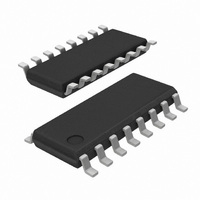SI3000-KS Silicon Laboratories Inc, SI3000-KS Datasheet - Page 15

SI3000-KS
Manufacturer Part Number
SI3000-KS
Description
IC VOICE CODEC 3.3V/5V 16SOIC
Manufacturer
Silicon Laboratories Inc
Type
Voice-Band Codecr
Specifications of SI3000-KS
Package / Case
16-SOIC (0.154", 3.90mm Width)
Data Interface
Serial
Resolution (bits)
16 b
Number Of Adcs / Dacs
1 / 1
Sigma Delta
No
Dynamic Range, Adcs / Dacs (db) Typ
84 / 84
Voltage - Supply, Analog
3 V ~ 5.25 V
Voltage - Supply, Digital
3 V ~ 5.25 V
Operating Temperature
0°C ~ 70°C
Mounting Type
Surface Mount
Number Of Adc Inputs
3
Number Of Dac Outputs
2
Conversion Rate
12 KSPs
Interface Type
Serial
Resolution
16 bit
Maximum Operating Temperature
+ 70 C
Mounting Style
SMD/SMT
Minimum Operating Temperature
0 C
Number Of Channels
1 ADC, 1 DAC
Lead Free Status / RoHS Status
Contains lead / RoHS non-compliant
Lead Free Status / RoHS Status
Lead free / RoHS Compliant, Contains lead / RoHS non-compliant
Available stocks
Company
Part Number
Manufacturer
Quantity
Price
Part Number:
SI3000-KS
Manufacturer:
SILICONLABS/èٹ¯ç§‘
Quantity:
20 000
Programmable Output Gain/Attenuation
Prior to D/A conversion, the Si3000 contains a digital
programmable gain/attenuator which provides up to 12 dB
of gain or –34.5 dB of attenuation in 1.5 dB steps. Level
changes only take effect on zero crossings to minimize
audible
implemented if no zero crossing is found after 256 frames.
Write the DAC Volume Control (register 7) to set digital
input gain/attenuation.
Line Output
LINEO is a line level analog output signal centered around
a common mode voltage. The minimum recommended
load impedance is 600 . This output is a fully filtered
output with a 1 Vrms full scale range. The only external
component required is the 10 F DC blocking capacitor
shown in Figure 13 on page 12. This output may be muted
through the LOM bit in register 6 or attenuated by setting
the analog attenuation bits in register 9.
Speaker Output
The SPKRL and SPKRR analog outputs are capable of
driving a small loudspeaker whose impedance is typically
32
may be muted through the SLM and SRM bits in the DAC
Gain Control register 7 or attenuated by setting the analog
attenuation bits in register 9.
Digital Interface
The Si3000 has two serial interface modes that support
most standard modem DSPs. These modes are selected
by the addition of a 50 k
SDO and SCLK pins as shown in Figure 13 on page 12. To
determine the mode, the Si3000 reads SDO and SCLK on
the first rising edge of MCLK after RESET goes low. The
key difference between these two serial modes is the
operation of the FSYNC signal. Table 11 summarizes the
serial mode definitions.
The digital interface consists of a single synchronous serial
link which communicates audio and control data.
In slave mode, SCLK is connected only to the pullup/
*Note: Pull-up/pull-down states
Mode SCLK* SDO*
0
1
2
3
(see Figure 13 on page 12). The speaker outputs
artifacts.
0
0
1
1
Table 11. Serial Modes
The
0
1
0
1
FSYNC frames data
FSYNC pulse starts data
frame
Slave mode
Reserved
requested
pull-down/up resistor on the
Description
level
change
Rev. 1.1
is
pulldown resistor, and MCLK is a 256 Fs input which is
internally multiplied using the on-chip phase-locked loop
(PLL) to clock the A/D converter and D/A converter. In
master mode, the master clock (MCLK) is an input and the
serial data clock (SCLK) is an output. The MCLK frequency
and the value of the sample rate control registers 3 and 4
determine the sample rate (Fs). The serial port clock,
SCLK, runs at 256 bits per frame, where the frame rate is
equivalent to the sample rate.
Digital information is transferred between the DSP and the
Si3000 in the form of 16-bit Primary Frames and 16-bit
Secondary Frames. There are separate pins for receive
(SDO)
simultaneous receive/transmit operation within each frame.
Primary Frames are used for digital audio data samples.
Primary Frames occur at the frame rate and are always
present.
Secondary Frames are used for accessing internal Si3000
registers. Secondary Frames are not always present and
are requested on-demand. When Secondary Frames are
present, they occur mid-point between Primary Frames.
Hence, no Primary Frames are dropped.
On Primary Frame transmits (DSP to Si3000), the Si3000
treats the LSB (16th bit) as a flag to request a Secondary
Frame. Therefore, out of 16-bits of transmit data on SDI,
only 15-bits represent actual audio data. When secondary
frames are not present, no transmission occurs during this
time slot.
On Primary Frames receives (Si3000 to DSP), the Si3000
drives SDO with 16-bits of audio data, if the Si3000 is in
either Serial Mode 0 or 1. However, if the Si3000 is in
SLAVE mode (Mode 2), the Si3000 supplies 15-bits of
Audio Data to the DSP and always drives the LSB zero.
This feature is designed to work with the Si3021 register 14
SSEL set to 10. In this system configuration, when the
DSP receives Primary Frames, it can check the LSB to
determine whether the receive data is from the Si3021 or
from the Si3000.
On Secondary Frame receives and transmits; the Si3000
treats the input and output serial stream as 16-bits of data.
Figure 15 shows the relative timing of the serial frames.
Figure 16 and Figure 17 illustrate the secondary frame
write cycle and read cycle, respectively. During a read
cycle, the R/W bit is high and the 5-bit address field
contains the address of the register to be read. The
contents of the 8-bit control register are placed on the SDO
signal. During a write cycle, the R/W bit is low and the 5-bit
address field contains the address of the register to be
written. The 8-bit data to be written immediately follows the
address on SDI. Only one register can be read or written
during each secondary frame. See "Control Registers‚" on
page 20 for the register addresses and functions.
and
transmit
(SDI)
functions,
Si3000
providing
15













